
Description
A stable block runs along the main road from which turrets swell out; between them there is an opening which leads up to the entrance front, a conventional Tudor elevation.The garden front, however, is very eccentric. It is broken into three different elements. On the left there is a tile-hung block with its own hipped roof and corner leaded windows. In the centre there are a pair of gables reminiscent of the M-form gable seen on most semi-detached houses in the inter-war period. These gables are supported on paired wooden columns and have brackets with a very flat bolection mould similar to forms used at this time by Mackmurdo and Voysey. (Amery et al., 1981, cat no.115) 1897–8 by Lutyens but little known and rarely published. It is one of his houses, between the early Surrey vernacular and later classicism, in which the influence of Art Nouveau and the more avant-garde English architects, such as E.S. Prior, may be identified. Designed for Archibald Grove, editor of the New Review and M.P.; Lutyens and his wife were family friends and often stayed here. The site was merely fields on an exposed hilltop, and Lutyens used the existing field boundaries to structure his design. Highly characteristic are the high walls to the main road, roughcast with a tile capping and silent about what lies behind. They curve in to a gatehouse range, long and low with a half-hipped tile roof. To the r., the lodge, indicated by chimneys, a dormer and just one window, tucked under the eaves. Steps up to an arched doorway with voussoirs of tile creasing. l., the stables, with a high loft dormer and an oculus. In the middle, the entrance is flanked by low rounded turrets, almost pushing themselves out of the walls, with tiny square windows under the eaves and conical roofs finishing in lead spikes. Above is a gabled dormer with a clock, and a weathervane. The composition is a vernacular version of Lutyens’s Georgian gatehouse at The Salutation of 1911.
From here there is an axial entrance sequence to the front door. First, an outer walled courtyard with formal planting, and then a smaller inner courtyard enclosed by high walls. Either side of the opening into this the curved ends of the tile capping shelter small lanterns, and to l. and r. the walls are pierced by round arches. The front of the house is quite simple, also roughcast, with a hipped tile roof and central two-storey gabled porch, not unlike Baillie Scott. This is womb-like inside, barrel-vaulted with a splendid two-panelled door, the upper panel glazed with exaggerated Mannerist lugging. It is flanked by small square windows on the ground floor and larger windows above, a strip to light bedrooms on the l. and a deeper, mullioned-and-transomed, window marking the staircase to the r. The garden side is in complete contrast, restless and disjointed, with apparently no order. The relationship between the built forms and the internal spaces, particularly on the ground floor, is tenuous. In the middle, a large M-shaped tile-hung gable, the eaves sweeping down to the ground-floor window height on each side. Large ground- and first-floor leaded windows and attic windows in the pair of small upper gables. l. and r., loggias supported on paired brick piers and long wooden brackets with the flat bolection curve that, as Gradidge points out, is so typical of Art Nouveau. To the l., and quite separate, another two-storey element, its roof hipped to the l. and returning around the side, but with a gable end to the r., as though part of it had been shorn off. Full-width mullioned-and-transomed window to the ground floor, returning around the corners, and a pair of smaller windows wrapping around the corners of the tile-hung first floor. As built, that was it, but c. 1926 a kitchen wing was added to the r., creating a third element to this extraordinary composition. The architect is unknown, but it is a creditable essay in Lutyens’s language with a two-storey bay window under a projecting tile-hung gable.
The planning is simple: the porch leads to a lobby, then into a hall with windows under the rear loggia. The drawing room is r., the dining room l. The staircase rises from the back of the hall. Lutyens’s interiors were plain – plastered walls, flush skirtings etc. – but the rooms had already received a Neo-Georgian overlay c. 1905. Lobby, hall and staircase have 1920s panelling. The staircase is Lutyens and an uncharacteristically historicist piece, in the style of the late c17 with bulbous turned balusters and square newels with finials. A remarkable Mannerist stone chimneypiece (cf. Overstrand Hall, Norfolk) was removed in 1926, but reconstructed to Lutyens’s design in 2005. Also, discovered in the hall were mural drawings by Lutyens, in the form of fictive panelling with birds and figures, including a baby, reputedly his eldest daughter Barbara.
Little of the original garden planting by William Robinson survives, apart from some formal yews. nw of the house is the large chalk-cob walled garden with a triple-gabled bothy in one corner. In the sequence of outdoor rooms created by the forecourts and walled garden Lutyens anticipates his Greywalls, Lothian (1900). (Bullen et al, 2010, pp.179-80)
Bibliography
Amery, C., Richardson, M. and Stamp, G. (1981) Lutyens, the Work of the English Architect Sir Edwin Lutyens (1869-1944): Hayward Gallery London, 18 November 1981-31 January 1982. London: Arts Council of Great Britain.Bullen M, Hubbuck R, Crook J & Pevsner N (2010) Hampshire: Winchester and the North. The Buildings of England. New Haven: Yale University Press.
Also Cited In
Richardson, M. (1973) Catalogue of the Drawings Collection of the Royal Institute of British Architects: Edwin Lutyens. Farnborough: Gregg International Publishers.Gradidge, R. (1980) Dream houses: The Edwardian ideal. London: Constable & co. ltd.
Gradidge, R. (1982) Edwin Lutyens: Architect Laureate. London: Allen & Unwin.
Pevsner, N. (1962) Hampshire. The Buildings of England. Harmondsworth: Penguin.
Listing Grade
IListing Reference
1302517Client
Archibald Grove


